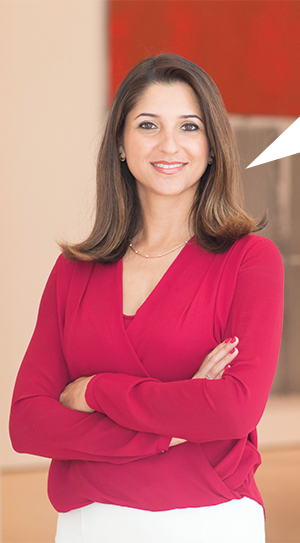One of the reasons we launched our Powherful Forces column was to shed light on the fact that even though the electric power industry is dominated by men, there are plenty of female executives who have the education, intelligence and professional experience necessary to participate in propelling our industry forward.
Nooshin Behroyan is no exception. After graduating from high school a year early, Behroyan went directly to college, where she earned a bachelor’s degree in architecture. Working for an architectural firm, Behroyan designed mixed-use high-rises sites in California, India and the Philippines, as well as major cities around the globe. While visiting a site at one of those locations, she disagreed with the structural engineer on the job, but without an engineering degree or experience, she didn’t have the credibility to override him.
So, Behroyan returned to school to pursue her Master of Science in civil and environmental engineering. For her thesis, she conducted research with the California Department of Oil and Gas, which opened the door to her career in natural gas projects. It was around that period when a natural gas pipeline in San Bruno, CA exploded. Behroyan was one of the project managers consulting for PG&E with the pipeline safety enhancement program to ensure proper testing, audit and compliance of other gas pipelines in Northern California, including the infrastructure rebuild of San Bruno. With that, Behroyan’s career on the utility side of the power industry was born.
In 2016, Behroyan founded Paxon Engineering and Infrastructure, a consulting management firm focused on improving critical infrastructure in the oil, gas and utility industries. Four
years later, Paxon was ranked 9th on the Inc. 5000 list of fastest-growing companies. With a staff of nearly 200 and dozens of contractors across the U.S., Paxon works with its clients from a program’s initiation throughout its lifecycle, with services that include strategic planning and program management, compliance, quality management assurance and safety services for the electric utility field workers and natural gas pipeline operators.
One of the core issues that inspired Behroyan to create Paxon is the relationship between climate change and infrastructure. Earlier in her engineering career, Behroyan recognized there wasn’t much being done on the natural gas side to reduce the effects of climate change. This prompted her to meet with utility executives, where she told them, “Look, you are not tracking your natural gas release into the atmosphere during the pipeline maintenance projects or anytime there is a leak on transmission or distribution.”
In keeping with Behroyan’s desire to mitigate climate change, Paxon was able to raise $34m in the project budget to establish a leaks management program and began using zero-emission vacuum and compression equipment that moves gas out of the pipeline being depressurized into another section of the pipeline system.
Behroyan considers climate change to be just one factor in what she refers to as “the related risk of everything.” As she explains, “It’s really about looking at infrastructure in general. We need to think about how we are making key decisions about planning and building an infrastructure that is not just looking out 10 years ahead, but 50 or 100 years ahead. We need to consider how this infrastructure will affect our climate now and in the future”.
On the services side of Paxon, Behroyan is excited about the work the research and development department is doing with microgrids. Currently, the R&D team is examining how to establish a critical infrastructure that will allow Paxon’s utility clients to better themselves, such as implementing technology that limits the intensity and effects of power outages. The way Behroyan envisions it is if the grid is divided up appropriately, with proper automation and microgrid establishment, a public safety power shutoff doesn’t have to take out a whole county, but instead, only take out the area considered high-risk.
The fact that she has made remarkable inroads in a male-dominated industry, speaks volumes about Behroyan’s intelligence, vision and business acumen, but her ability to address situations from both analytical and abstract approaches factor significantly into her success.
“I do well in an abstract environment,” says Behroyan. “I was trained as a classical pianist. Then, when I moved to the U.S. from Iran, I learned jazz. When you play jazz, you have to recreate the music. You may be playing the same melody, but you’re always recreating, and no two pieces are the same.”
Throughout her career, Behroyan has applied a similar blend of analytical and creative approaches to her work. “When you’re developing architecture, you’re creating,” she says. “You’re creating space that is ergonomically friendly because when people feel comfortable, there’s a sense of trust in that space. I’ve always contemplated things like ‘how do you make a space smart so that it generates its own energy?’ so when you combine all of that analysis and expertise and bring them into an organization like Paxon, you are now looking at infrastructure with a mindset that asks, ‘How is it serving the people? How will it sit in the planet, how might it scar the planet, and how can you minimize that damage?’”
Behroyan understands that many may believe infrastructure is all about analytics and numbers, but she believes that when done properly, and if it includes plans for upgrades and retrofitting, infrastructure is more of an abstract concept, in that you have to think many years ahead to be able to create an infrastructure that will continue to serve its customers. She also views proper retrofitting of existing infrastructure for the future of carbon reduction to be one of the greatest challenges the power industry faces right now. “Yes, we need alternative fuels,” says Behroyan, “but all of those new fuels require new infrastructure. So much money has gone into building the infrastructure, so the challenge for the industry is not just saying no to natural gas and using only electricity or other renewable energy. Instead, we have to take a middle path and look at how we can leverage our existing infrastructure.”
Behroyan draws upon both her analytical d and creative sides when describing the role she and her fellow engineers will play in the future of infrastructure. “When I talk about the need to plan ahead. I’m not just talking about a few years from now, but centuries from now. We need to plan that far because it is our job is to make the planet a better place with cleaner, safer energy that we can pass on to future generations.”
Comments from Nooshin Behroyan on a woman’s work
in what traditionally has been a man’s industry
 Nooshin Behroyan has 17 years of oil, gas and utilities industry experience that includes integrity management, construction management and inspection, engineer, procurement and construction (EPC) for pipeline and electric grid infrastructures. Her company, PAXON, which she founded in 2016, was named 9th fastest growing company in America on the Inc. 5000 list and the No.1 female-led company on the same list two years in a row. As a first-generation immigrant and a single mother, Behroyan brings extensive cross-cultural experience that promotes gender diversity and work-force equality by addressing barriers and driving change for positive impact for women engineers and veterans. Behroyan serves as the board president for National Association of Women Business Owners (NAWBO)- San Francisco Bay Area, as well as, chairwoman of the advisory board of IKAR Energy Group, and the advisory boards for American Gas Association (AGA). She holds a B.A. in architecture from UC Berkeley, M.S. in civil and environmental Engineering from UC Davis and is a graduate of UCLA’s MDE Program. She is also a professionally trained piano player and has played for the U.C. Berkeley Jazz Ensemble.
Nooshin Behroyan has 17 years of oil, gas and utilities industry experience that includes integrity management, construction management and inspection, engineer, procurement and construction (EPC) for pipeline and electric grid infrastructures. Her company, PAXON, which she founded in 2016, was named 9th fastest growing company in America on the Inc. 5000 list and the No.1 female-led company on the same list two years in a row. As a first-generation immigrant and a single mother, Behroyan brings extensive cross-cultural experience that promotes gender diversity and work-force equality by addressing barriers and driving change for positive impact for women engineers and veterans. Behroyan serves as the board president for National Association of Women Business Owners (NAWBO)- San Francisco Bay Area, as well as, chairwoman of the advisory board of IKAR Energy Group, and the advisory boards for American Gas Association (AGA). She holds a B.A. in architecture from UC Berkeley, M.S. in civil and environmental Engineering from UC Davis and is a graduate of UCLA’s MDE Program. She is also a professionally trained piano player and has played for the U.C. Berkeley Jazz Ensemble.







